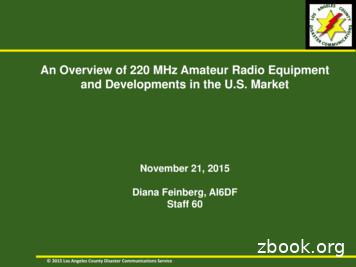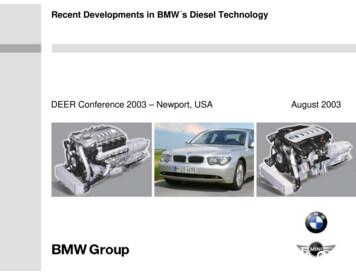Technology Developments To Enable On-Board Hydrogen
Technology Developments to EnableOn-Board Hydrogen StorageAdvanced Clean Cars Symposium:The Road AheadDiamond Bar, CaliforniaSeptember 27, 2016Ned T. Stetson, Ph.D.Hydrogen Storage Program ManagerFuel Cell Technologies OfficeU.S. Department of Energy
Hydrogen Storage Technology Development:Parallel paths to address near and long-term needsFuel Cell Technologies Office 2Near-term – address cost and performance of 700 bar H2 storage;Long-term – develop advanced technologies with potential to meet all targets
Current status for H2 Storage on Fuel Cell VehiclesFuel Cell Technologies Office 3H2 fuel cell electric vehicles Models available for lease or sale in certaingeographic areas around the world 700 bar (70 MPa; 10,000 psi) onboard storage Type IV composite overwrapped pressure vessels Driving range: 265-312 miles* 700 bar refueling infrastructure being deployed incertain geographic areas Fill times as low as 3 minutes* Ranges based on EPA estimates for 2016 model year vehicles: https://www.fueleconomy.gov/feg/fcv sbs.shtmlH2 fuel cell forklifts/pallet jacks 350 bar onboard storageType I/III/IV pressure vesselsPerformance benefits over battery forklifts350 bar refueling infrastructure deployed, butat a premium over battery chargingInitial commercialization occurring with compressed H2 storage
Examples of On-Road DemonstrationsFuel Cell Technologies Office 4Chassis StyleFuel Economy inmiles / kg H2 (City /Hwy)DrivingRange(miles)YearReported350 barCompact Car48/532002006Nissan X-trail350 barCompact SUVno ref2292006Chevrolet Equinox700 barCompact SUV471992007Kia Borrego700 barFull-size SUV604702010Toyota HighlanderFCHV-adv700 barFull-size SUV583502011Honda Clarity350 barMid-size Car60/602402012Mercedes-Benz F-Cell700 barSubcompact Car52/531902012Hyundai Tucson700 barCompact SUV502652014Toyota Mirai700 barSubcompact Car663122015FCEVStorageTechnologyFord FocusToyota MiraiChevroletEquinoxPhoto Credit: Hyundai MotorPhoto Credit: Ford MotorPhoto Credit: Honda MotorHyundai TucsonFord FocusPhoto Credit: Toyota MotorPhoto Credit: GMMercedes-BenzF-CellHonda ClarityPhoto Credit: Daimler AGCompressed gas storage delivers acceptable driving ranges for some vehicle platforms
700 BarH2 StorageSystem PerformanceProjected700 Bar Type IV System Compared Against 2020 TargetsFuel Cell Technologies Office 5(Single Tank)Projected AgainstDOE 2020 TargetsGravimetric DensityStart Time to Full Flow (20 C)Fill Time (5kg H2)Start Time to Full Flow (-20 C)100%80%Min. Delivery Temp.Max Delivery Temp.Min. Delivery Pressure60%40%Transient ResponseMax. Operating Temp.20%Fuel PurityMin. Operating Temp.0%Wells-to-Power PlantEfficencyMax. Delivery PressureLoss of Useable H2Min. Full Flow RateFuel CostSystem CostCycle Life (1/4 - full)Based on FCTO Program Record 15013Fuel Cost assumes Central SMR Delivered & DispensedSource U.S. Department of EnergyOnboard EfficiencyVolumetric Density
Current Technology700 Bar H2 Storage System PerformanceFuel Cell Technologies Office 6Projected Against DOE Ultimate Full Fleet TargetsSource U.S. Department of Energy
Baseline 700 Bar System ConfigurationFuel Cell Technologies Office 7Single-tank configuration is used in cost and performance models1.2.3.4.5.6.7.8.9.10.11.12.Manual OverrideFilterCheck ValvePressure TransducerTemperature TransducerThermally-activated Pressure Relief Device (TPRD)Excess Flow ValveAuto Solenoid ValvePressure RegulatorManual Defuel Valve & Defueling ReceptacleAutomated Shutoff ValveTemperature SensorG. Ordaz, C. Houchins, and T. Hua, “Onboard Type IV Compressed Hydrogen Storage System – Costand Performance Status 2015,” DOE Hydrogen and Fuel Cells Program Record #15013, Nov. 25, 2015.
Composite Overwrapped Pressure VesselsFuel Cell Technologies Office 8
700 Bar System CostFuel Cell Technologies Office 9Source U.S. Department of EnergyCost targets cannot be met without significant reduction in high-strengthcarbon fiber composite costs – Where can the costs be reduced?
Lower Cost Precursors for Carbon FiberCommercial Textile (PAN/MA) PrecursorsMelt Processable PAN Precursors(Oak Ridge NL) – Project completed(Oak Ridge NL) Precursors account for 55% of cost ofcarbon fibers Textile PAN fibers 25% lower cost thanconventional PAN fiber precursors Potential fast-track, drop-in replacementprecursor Projected CF costs of 23.43/kg, savings of 5/kg compared to Toray T-700S Target: 25% reduction in costs ofmanufacturing of carbon fiber Cost reduction achieved throughlower capital costs and lowerprocessing costs vs conventional wetspinning processes Alternative melt processableformulations to be developed anddemonstrated Feasibility demonstrated, scale-up inprocessMelt-processingExtrusionSpinning Low production cost High production rateG. Ordaz, C. Houchins, and T. Hua, “Onboard Type IV Compressed Hydrogen Storage System –Cost and Performance Status 2015,” DOE Hydrogen and Fuel Cells Program Record #15013, Nov.25, 2015.10 Fuel Cell Technologies Office Environment-friendlyWind-upeere.energy.gov
Balance of Plant Cost ReductionsFuel Cell Technologies Office 11Alternative MaterialsComponent IntegrationIntegrated pressure regulatorblockAnalysis YearBOPAssumptions/ChangesBOP Cost(2007 /kWh)2013(DOE Record)Majority of vendorquotations, limited byproduct availability2014DFMA analysis ofintegrated in-tank valveand pressure regulatorquotation update 4.37/kWhIntegrated pressureregulator block willreduce number of fittings(translates to other H2storage systems) 3.64/kWh2015(DOE Record)Combined empirical and computationalapproach to identify alternative materialsfor use in hydrogen service (SNL) Fatigue properties versus reduction intensile strength Computationally determine stacking faultenergy and strategies to control avings(%)RelativeMaterialCost (%)316L (A)1.01700100316L (CW)1.2570703621Cr-6Ni9Mn(XM-11)0.85406933304L (CW)1.05406826Nitronic 601.04155948SCF 2601.19658223 4.98/kWhG. Ordaz, C. Houchins, and T. Hua, “Onboard Type IV Compressed Hydrogen Storage System –Cost and Performance Status 2015,” DOE Hydrogen and Fuel Cells Program Record #15013, Nov.25, 2015.
Updated system cost - 700 bar single tank config. 17/kWh 15/kWhFuel Cell Technologies Office 12Strategies toReduce Cost ofCurrentTechnology Low-costcarbon fiberprecursors Balance ofplant (BOP)integration Low-cost andlow-densityresinsSource U.S. Department of Energy12% Net Cost Reduction since 2013
Current FCEVs use dual tank configurationsFuel Cell Technologies Office 13Honda ClarityHyundai Tucson Fuel CellPhoto Credit: Honda MotorToyota MiraiPhoto Credit: Hyundai MotorPhoto Credit: Toyota Motor
700 Bar System ConfigurationFuel Cell Technologies Office 14Dual-tank configurations are currently used onboard all commercial FCEVs todaySignificant increase in cost due to redundancies in balance of plant componentsData connection toVehicle SystemController(data communication lines)IntegratedIn-Tank ValveTemp.SensorTo VentTemp.TransducerTPRDAuto. Solenoid ValveFilterPlug & TPRD(for long tank)Fuel Tank Controllerincluding IR Transmitterto Refueling sureTransducerIntegratedIn-Tank Valve(connected to controller &IR Transmitter)PRVTPRDAuto. Solenoid ValveFilterPlug & TPRD(for long tank)FillReceptacleTo VentTemp. erridePressureRegulatorTwo sets of mountinghardware for each tankTPRD& activatedPressure ReliefDeviceTPRD Thermalthermallypressurerelief deviceBrian James, Strategic Analysis; Hydrogen and Fuel Cell Technologies Annual Merit Review and Peer Evaluation, /st100 james 2013 o.pdfManualDefuel Valve& DefuelingReceptacleAutomatedToShutoffFuel CellValveSystemPressure Transducer
Impact of # of tanks on system cost1 tank2 tanksFuel Cell Technologies Office 151 tank2 tanksBased on 5.6 kg usable H2 capacity systems (5.6 or 2.8 kg per tank), Type IV COPVs, L/D ratioof 3.0, 700 bar operation, safety factor 2.25B. James, A. Spisak, Strategic Analysis, presented to the US. DRIVE H2 Storage Technical Team, Nov. 15, 2012Balance of plant accounts for bulk of cost increase in multi-tank configurations
Current Technology700 Bar H2 Storage System PerformanceFuel Cell Technologies Office 16Projected Against DOE Ultimate Full Fleet TargetsSource U.S. Department of Energy
Conformable tanksConcept being developed by Center for Transportation and the EnvironmentFuel Cell Technologies Office 17Conformable pressure vesselsoffer potential of improvedpackaging onboard vehicles,eliminating need for multiplecylinders and redundant BOP
Comparison of H2 Densities at 350 and 700 BarFuel Cell Technologies Office 18Going to higher pressure is not a solution to improving H2 density
Hydrogen Storage Technology Development:Parallel paths to address near and long-term needsFuel Cell Technologies Office 19Near-term – address cost and performance of 70 MPa H2 storage;Long-term – develop advanced technologies with potential to meet all targets
Cold/Cryo-compressed H2 StorageHigher H2 densities are achievable through use of lower temperaturesLower Temperatureslead to Higher Energy DensitiesSource U.S. Department of Energy20 Fuel Cell Technologies Officeeere.energy.gov
Sub-ambient compressed H2 storageFuel Cell Technologies Office 21H2 fill lineSource: Lawrence Livermore National LaboratoryHigh-performance insulation used to extend dormancy and reducepressure build up and venting of H2 due to heat leakage
Examples of sub-ambient storage effortsFuel Cell Technologies Office 22OrganizationPressureTemperatureH2 Sys. DensityApplicationBMW 1300 bar 40 – 80 K 30 g/LLDVsLLNL 2700 bar 40 – 80 K50 g/LLDVsPNNL 3500 bar 200 K25 g/LLDVsANL 4tbd 40 – 80 KtbdBusesHSECoE 5 100 bar80 -160 K21 g/LLDVs, sorbents1: based on K. Kunze, O. Kircher, BMW Group, presented at the Cryogenic Cluster Day, Oxford, September 28, 9C-73BF-495B-B843DCDF50E8B5A5.pdf2: based on S. Aceves, G. Petitpas, V. Switzer, LLNL, presented at the Hydrogen and Fuel Cell Technologies AnnualMerit Review and Peer Evaluation Meeting, June 17, /st111 aceves 2014 o.pdf3: based on D. Gotthold, PNNL, presented at the Hydrogen and Fuel Cell Technologies Annual Merit Review and PeerEvaluation Meeting, June 9, 2016. 1 gotthold 2016 o.pdf4: based on personal communications about R&D being carried out by R. Ahluwalia, ANL, 2016.5: based on D. Anton, SRNL/HSECoE, presented at the Hydrogen and Fuel Cell Technologies Annual Merit Review andPeer Evaluation Meeting, June 9, /st004 anton 2016 o.pdfA range of pressures and temperatures are being investigated and havenot yet been optimized
Long Term Strategy-H2 Materials Based Storage:Potential for Higher H2 DensitiesFuel Cell Technologies Office 23ProjectedType IV SystemCompared Against2020 Targets700Bar 700H2BarStorageSystemPerformance(Single Tank)Projected Against DOE 2020 TargetsGravimetric DensityPhysicalStorageStart Time to Full Flow (20 C)Fill Time (5kg H2)Start Time to Full Flow (-20 C)100%Min. Delivery Temp.Max Delivery Temp.80%Min. Delivery Pressure60%40%700 barGen 2 vehicles40g/LTransient ResponseMax. Operating Temp.20%Fuel PurityMin. Operating Temp.0%Wells-to-Power PlantEfficencyMax. Delivery PressureLoss of Useable H2Theoretical limitations prevent 700bar from meeting all onboard targetsMin. Full Flow RateFuel CostSystem CostCycle Life (1/4 - full)Based on FCTO Program Record 15013Onboard EfficiencyVolumetric DensityFuel Cost assumes Central SMR Delivered & DispensedReferenceMaterialsStorageXinterstial hydrides complex hydrides chemical storage 70-150 g H2/L 100-150 g H2/L 70-150 g H2/LHigher densities potential to meet system targetssorbents 70 g H2/Lwater111 g H2/LSource U.S. Department of Energy
Bonding type in materialsPhysisorption (vander Waals)Covalent,Ionic, MetallicSource U.S. Department of EnergyFuel Cell Technologies Office 24Metallic,Ionic, CovalentCovalent, Ionic,Metallic
Example of a sorbent prototype systemMaterial-based systems must be able toexchange heat due to the endo/exothermicnature of the hydrogen sorption processesD. Anton, SRNL, Hydrogen and Fuel Cell Technologies Annual Merit Review and Peer Evaluation Meeting, June 9, /st004 anton 2016 o.pdfFuel Cell Technologies Office 25
Strategies for increasing energy densityFuel Cell Technologies Office 26MethodH2 DensityAdvantageDisadvantagecompression40 g/L (700 bar)simple, maturelow energy density, costliquefaction70 g/L (20 K)high density,low-pressureenergy penalty,cryogenic, dormancycold/cryocompressedup to 90 g/L(700 bar, 40 K)high density,Simple, fastrefuelingcryogenic, highpressure, dormancy,energy penaltyup to 150 g/Lhigh density,low-pressureweight, cost, complexitysorbentsup to 70 g/L (?)high density,low-pressure,kineticscryogenic, complexity,dormancyliquid carriersup to 120 g/L (?)high density,low-pressureregeneration efficiency,two-way, costMaterials-basedmetal hydridesThere is no perfect solution
Relationships between H2 deliveryand onboard storage optionsFuel Cell Technologies Office 27Storage OptionsDelivery Options700 BarColdCryocompressed compressed CryosorbentMetalHydride Liquid H2 Low Pressure( 200 bar) High Pressure( 200 bar) Pipeline rogen Precoolingneeded(down to-40 C)Refrigerationrequired(down to150 K)SupercriticalH2 needed( 150 K)Liq H2 or liqN2 needed(down to 80K) w/recirculationHeatrejection atforecourtmaybeneededMustrecyclespent fueloffboardDecisions on H2 delivery method and onboard storage technologycan create limitations on the available choice for the other
Fuel Cell Technologies Office 28Thank youDr. Ned StetsonProgram Manager, H2 StorageFuel Cell Technologies nergy.gov
1 tank 2 tanks 1 tank 2 tanks Based on 5.6 kg usable H 2 capacity systems (5.6 or 2.8 kg per tank), Type IV COPVs, L/D ratio of 3.0, 700 bar operation, safety factor 2.25 B. James, A. Spisak, Strategic Analysis, presented to the US. DRIVE
work/products (Beading, Candles, Carving, Food Products, Soap, Weaving, etc.) ⃝I understand that if my work contains Indigenous visual representation that it is a reflection of the Indigenous culture of my native region. ⃝To the best of my knowledge, my work/products fall within Craft Council standards and expectations with respect to
7 ADVANCED MENU - SETTING DEVICE FEATURE CONTROLS The Advanced Menu allows you to: n Enable or disable USB emulation support n Enable or disable Anytime USB Charge support. n Enable or disable the S-ATA controller n Enable or disable Virtualization Technology feature. n Enable or disable wake up on LAN feature. n Adjust the fan. (See Navigating through the Setup Utility on page 2 for
Recent Developments A Taste of My Research Representation of a Separable Preorder Framework and Information Two (or Three) Fundamental Principles A Theorem Outline Motivation Historical Background Early History Late 20th Century Consensus Recent Developments Developments within framework Multiple Dimensions of Poverty Time: Chronic and .
and Developments in the U.S. Market 1. Why so few choices in equipment until lately 2. History of the 222-225 MHz band and a new threat 3. Recent developments in 222-225 MHz mobile radios 4. Recent developments in 222-225 MHz handheld radios
Recent developments in etale cohomology David Hansen MPIM Bonn November 10, 2021 David Hansen Recent developments in etale cohomology 1/24. . History cont'd Some key later developments: Beilinson-Bernstein-Deligne-Gabber '83: Perverse sheaves, t-structures, decomposition theorem, purity for intersection
BUSINESS CHARTER April 2020 . Business Charter April 2020 Cote Developments LP Contents Cote Developments LP . practices, with a commitment to the bottom line, with an emphasis on value and service not be influenced by politics or social pressures. 5.2. Cote Developments LP will be accountable, transparent, and diligent in reporting in its .
PLANNING ADVICE NOTE - GOOD PRACTICE GUIDE ON BASEMENT DEVELOPMENTS 4 1.2 EY ISSUES AND LEGISLATIVE ROLES K The table below sets out the key issues relating to basement developments and their construction and how they relate to the different planning and buildings legislature (LBRuT Basement Developments - Review of Planning Implications, 2014).
EA Recent Developments in BMW s Diesel Technology. EA BMW Diesel History Recent Developments in BMW s Diesel Technology 3rd generation 2nd generation 1st generation 1985 1990 1995 2000 2005 DI-Engines IDI-Engines Spec. Power [kW/dm 3] 35 42 55 revision 2.5 - R6 - DI - VNT 3.9 - V8 - DI - VNT























